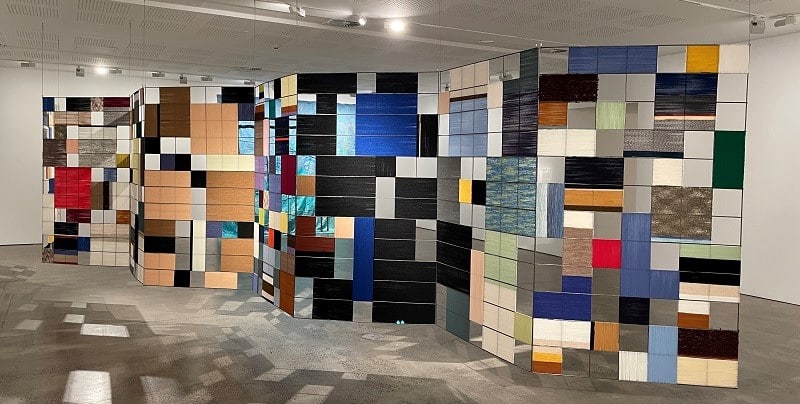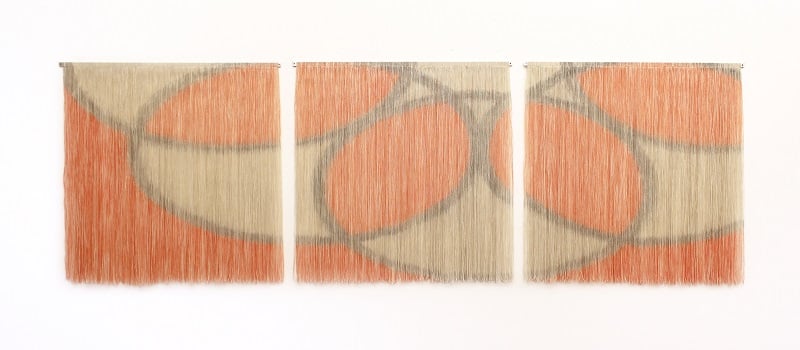Twelve leading contemporary Australian artists illustrate the possibilities and mutable nature of fibre and textiles as materials for art making in ‘Pliable Planes: Expanded Textiles & Fibre Practices’. Curated by Karen Hall and Catherine Woolley, this major exhibition of recent and commissioned works at UNSW Galleries in Sydney, presents a range of extraordinary artistic outcomes traversing painting, assemblage, sculpture, video, sound, and installation.
The title of the exhibition draws on a 1957 essay by Bauhaus artist Anni Albers “who sought to rethink weaving through the lens of architecture, interpreting textiles as fundamentally structural and endlessly mutable,” notes the gallery.

Working across hard and soft mediums both industrial and domestic, the artists, Akira Akira, Sarah Contos, Lucia Dohrmann, Mikala Dwyer, Janet Fieldhouse, Teelah George, Paul Knight, Anne-Marie May, John Nixon, Kate Scardifield, Jacqueline Stojanović and Katie West, investigate spatial fluidity, transformation, and processes of making with fibre and textiles.

Suspended from the ceiling in the gallery reception is Yindjibarndi woman and artist Katie West’s Sunrise after sunrise, sunset after sunset (2022–ongoing), a vibrantly coloured set of soft falling banners made from recycled and naturally dyed swatches of fabric sewn together, and patchworked with images of dilly bags. Inspired by the basket-making traditions of West’s grandmothers over generations, she says, “I’m motivated to make these pieces because it is a way to make these baskets present in my life and for my family, including the next generations of our family line. I want the children in my family to always know their ancestors made these baskets.”
A kaleidoscope of colour and geometric shapes cut through the main gallery with artist and weaver Jacqueline Stojanović’s Concrete Fabric (2019), a large suspended metal-framed grid-like structure woven in wool, a creative apparition that reflects “the architecture of socialist apartment blocks in former Yugoslavia.”
A series of plinths host works by Torres Strait Islander artist Janet Fieldhouse. Inspired by ceremonial adornment and basketry, these works bring traditional weaving practices and natural fibres; pandanus, sedge grass, and palm leaf, together with ceramics made of Keraflex porcelain, a malleable and unpredictable material that can shapeshift during the firing process, often resulting in collapsed or folded over objects.
Moving through the gallery six recreated paintings titled Quatrefoil 1 – Weft and Quatrefoil 2 – Weft (2022) by Lucia Dohrmann whose labour-intensive process of removing the ‘weft’ threads of each original painted canvas leaving only the ‘warp’ threads, form a series newly imagined fringe-like paintings “leaving behind a ghostly memory of the painted image”.
Kate Scardifield’s video presentation You Don’t Need Me To Tell You (2022) presents a captivating vision of the artist working her textile-based wind instruments made from sailcloth in a dance with the landscape that manifest “a sequence of shapely poetic gestures that study the body, material, and landscape.”
Different in materiality and process, two works by Sarah Contos face each other back in the main gallery. Voltron II (Studs) (2019) is a dramatic wall-based installation made of many leather jackets sewn together in symmetrical fashion, and Two Minutes and Six Seconds of Bubblegum (2022), which is one of seven commissioned works in ‘Pliable Planes’, presents the artists new material explorations with cast aluminium and in this particular work, Contos’ metal objects are paired with bright fluffy pom poms.
Click here for our Interview with Sarah Contos as she shares the inspiration behind her works in ‘Pliable Planes’.
To explore more of the works in ‘Pliable Planes’ visit UNSW Galleries, which is located on the corner of Greens Road and Oxford Street, Paddington. The show is on view until 17 July. Gallery open times: Wednesday to Friday, 10am to 5pm and Saturday and Sunday, 12 to 5pm.